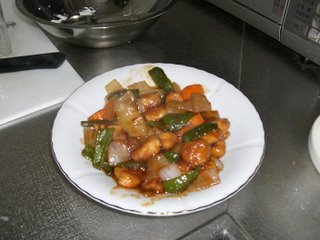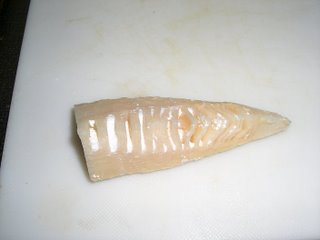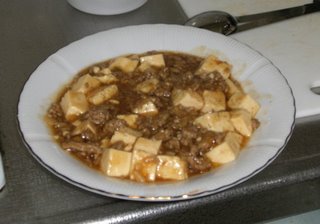お料理(酢豚)
More Nintendo goodness as I continue on my quest to learn to cook more than just rice. The first time I made this, I figured I'd never make it again since it was a LOT of work. But it ended up being the best tasting thing I've made so far, so I gave it another shot tonight. It went much more smoothly the second time around, so wheeeeeeee.

Sweet-and-Sour Pork
Yield: 1
Ingredients:
• 80 g pork thigh (I used chicken instead since the local store is ALWAYS out of the meat I want)
• 1 tsp sake
• 1 tsp soy sauce
• Potato starch (as needed)
• Frying oil (as needed)
• 1/4 onion
• 25 g boiled bamboo shoot (looks and smells FOUL, as you'll see, but tastes fine once cooked, I swear)
• 1/2 bell pepper (Japanese peppers are tiny, so I used a whole one)
• 10 cm carrot
• 1 dried shiitake mushroom (UGH. I definitely left this out)
• 1/2 slice canned pineapple (I used 2 whole slices)
• 1 tsp salad oil
• 1/2 tbsp water
• 1/4 tbsp potato starch
• 1/4 tsp Chinese soup stock granules
• 1/4 cup water
• 1 1/2 tbsp sugar
• 1 tbsp vinegar
• 3/4 tbsp soy sauce
• 1 tsp ketchup
• Dash of salt
Preparation:
In a small bowl, add some lukewarm water and the 1 dried shiitake mushroom, then cover with a paper towel. Let sit for 20 minutes. Remove the mushroom once it is soft enough to be bent and pierced with a fingernail. Set aside.
In a small bowl, mix together 1/4 tsp Chinese soup stock granules, 1/4 cup water, 1 1/2 tbsp sugar, 1 tbsp vinegar, 3/4 tbsp soy sauce, 1 tsp ketchup, and dash of salt. Set aside.
Cut the 80 g of pork into 1-inch cubes. Place the pork in a small bowl, then cover with 1 tsp soy sauce and 1 tsp sake. Set aside.

This is what your grandmother's yeast infection looks like.
Cut the 25 g boiled bamboo shoot into 1-inch pieces. Peel the 10 cm carrot and cut into bite-sized pieces. Place the bamboo and carrots into a water-filled pot and turn on the heat. Boil until the carrots are a little soft, then empty both vegetables into a collander. Set aside.
Peel and cut the 1/4 of an onion into 1-inch pieces. Remove the seeds and core of the 1/2 of a bell pepper, then cut into 1-inch pieces. Cut the rehydrated shiitake mushroom into quarters. Cut the 1/2 of a pineapple slice into 6 chunks. Set aside.
In another bowl or plate, add some potato starch. Coat each of the pork cubes evenly. Set aside. (A note about this step and the next one: I decided not to deep fry any meat since I didn't have a cooking thermometer and also had no way to dispose of the used oil. What trash category would it go into?! So I simply coated my meat in flour and pan-fried it with some oil to a golden brown. But do what you like.)
In a pot, add some frying oil and heat to 180°C (356°F). Add the pork cubes and deep fry until golden brown, then turn off the heat. Put the cubes on a paper towel to drain.
In a small bowl, mix together 1/4 tbsp potato starch and 1/2 tbsp water. Set aside.
Add 1 tsp salad oil to a frying pan and set on medium heat. Stir-fry the bamboo shoots, carrots, onion, bell pepper, and shiitake mushroom. Add the soup stock mixture and bring to a boil. Add the fried pork and pineapple chunks, then bring to a light boil. Add the potato starch mixture and stir well.
Transfer to a plate and enjoy.
***
When I mentioned to people at work that I made this (they seem very concerned that I'm starving to death and so ask me about food CONSTANTLY), they declared that this wasn't a meal. A dinner without rice in Japan is apparently not even edible. So if you want to avoid the wrath of the entire country of Japan, I recommend you make some rice, too. Also, if you have the means, I'd highly recommend adding some water chestnuts to the mix. They are so choice. However, I haven't been able to find ANY in Japan, and nobody at the store had even heard of them. Alas.












